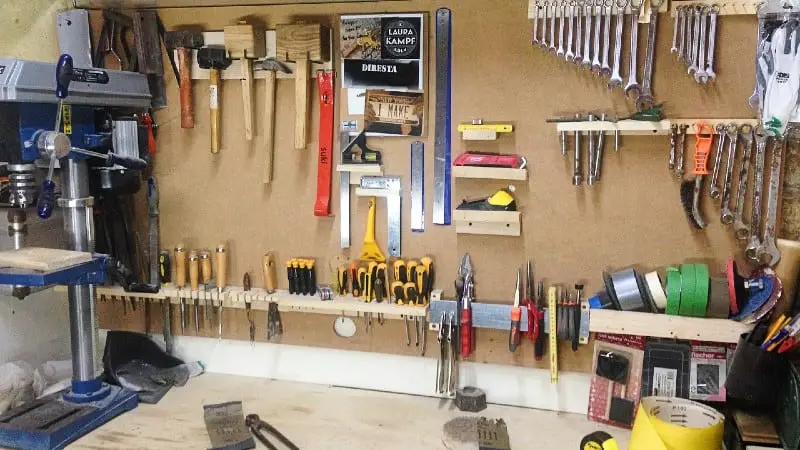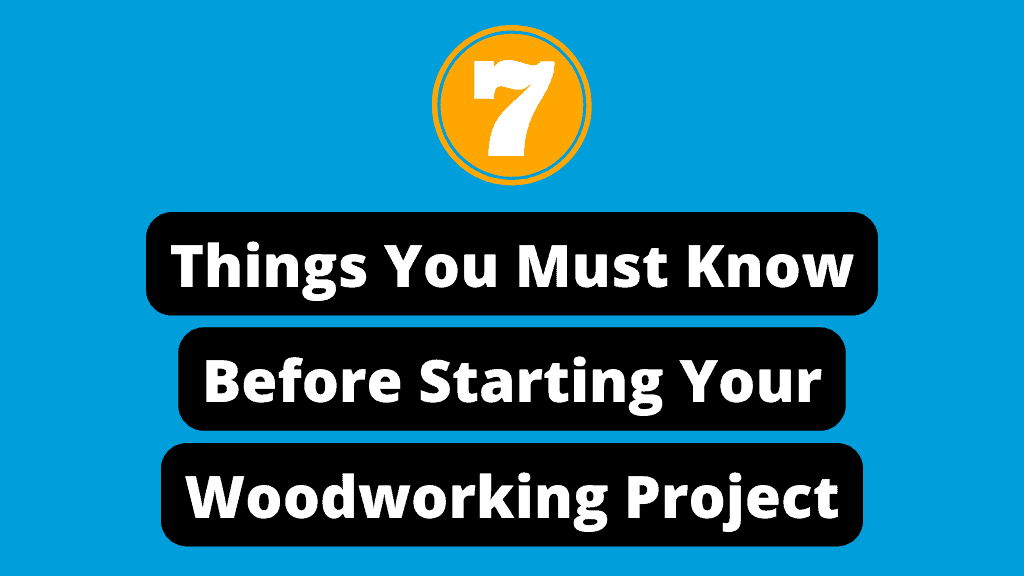Starting your first woodworking project can be an incredibly rewarding experience—but it can also be a little intimidating.
You don’t need to be afraid of getting started, though! The key is to be prepared and know what you’re in for. Here are 7 things you absolutely must know before starting your first woodworking project:
#1. Do not be intimidated by projects that require many steps to complete: Things You Must Know Before Starting Your First Woodworking Project
Starting out in woodworking can be intimidating. There are so many different tools and techniques, it can feel like there’s an insurmountable learning curve. But don’t let this get you down! There’s a way to make all of those steps manageable and enjoyable: start with small projects that require fewer steps, then build up to more advanced ones.
That said, don’t let the fact that a project may take more than one step to complete scare you away from tackling it.
One example of a simple project is making a cutting board or even just a single wooden spoon while an example of something more complex would be building an entire kitchen table by yourself. Both are fantastic, but begin with the simpler ones as you build your confidence and skill set in order to tackle the bigger projects whenever you feel ready for them.
There are plenty of easy woodworking projects for beginners that do not require a lot of time or materials. In fact, if you have the right tools and supplies, you can complete many projects in just a few hours.
Here are some examples of simple woodworking projects that can be put together quickly:
- Bookends
- A spice rack
- A wine rack
- A towel rack
- An iPhone dock
- A napkin holder
- A book stand
- A phone stand
- Make an old-school wooden pencil holder
- Wooden doorstop
- Paint wooden clothespins to make figurines
- Simple wooden candle holder
- Wooden coat rack
- Make yourself a wooden picture frame
- Add a bit of elegance to your space by building yourself a wooden jewelry stand
- A wooden doorstop that’s so cute, you won’t want to tuck it away in a closet
- A modern floating bookshelf that will look perfect in every room of your home
- A wooden spoon rack for the kitchen
- A homemade cutting board (this is a good one because it’s something you can use in the kitchen!)
- Make a wooden sign

#2. Know which tools you will need before you start: Things You Must Know Before Starting Your First Woodworking Project
Before you start a new project, you’ll want to make sure you have all the right tools on hand. You may not need ALL of these things every time, but it’s a good idea to familiarize yourself with the basics before you get started. Here is a list of several basic tools you need:
Hammer
A hammer is used for driving nails into your project, such as if you are nailing a piece of plywood to the frame of your newly-created coffee table. When it comes to hammers, there isn’t a one-size-fits-all solution. You’ll want to make sure you have one that’s been designed for the type of nail you’ll be using. For example, if you’re using small finishing nails, then you’d use a hammer with a small face.
Drill
If you plan on including anything that requires screws or putting objects together, a drill is absolutely essential. A cordless drill is useful when you don’t have access to an outlet nearby. You can also find drills that come with different bits for different tasks.
Tape measure
You can’t see a project through from start to finish without knowing how much material you need! Use this tool to measure any material before purchasing or cutting it.
Saw
You’ll use a saw to cut through your material. The best choice will depend on what type of project you’re working on—there are many different types of saws available, and they each serve a very specific purpose.
Screwdriver
A basic screwdriver will allow you to tighten or loosen screws as needed during your project.
Level
A level will help you ensure that your piece is straight and even. It’s also great for making sure shelves aren’t crooked!
I wrote another article about the tools needed for a workbench.
#3. Know how to use your tools
It’s not enough to just have the tools. You need to know how to use them, too. This means knowing how they work and what they can do. You also need to be comfortable with each one of them, especially when using it the first time. This way, you’ll be able to use it properly without putting yourself at risk of injury or damaging the material you are working on.
For example, let’s say that you’re building a birdhouse. To make sure that everything is secure and stable, you’re going to need a drill and some screws. If you don’t know how to use a drill, though, you might struggle with installing your screws in the right spots—or even end up drilling holes through the wrong part of your wood!
It would also help if you take the time to practice using your tools before starting your woodworking project. This will help make sure that you are confident in what you are doing and that you have everything needed on hand. You can do this by doing a dry run using scrap materials or taking the time to try out all of your tools with a piece of wood that is not going to be used in your project.

#4. Be safe when you are using your tools
Safety is a major concern when working with wood and power tools. To keep yourself and your family safe while woodworking, it’s important to follow some basic rules:
- Always wear a dust mask or respirator, safety glasses, and hearing protection when operating power tools.
- It’s also important to roll up long sleeves and tie back long hair before you start working with power tools. You don’t want an untucked end of a shirt sleeve getting caught in the blade of a circular saw or table saw! The same goes for long hair—if it isn’t tied back and off your neck, there’s always the chance it could get caught in your tools as well.
- Make sure you have shoes that cover the whole length of your foot (so no flip flops or open-toed sandals), preferably with leather soles that are non-slip. Those soles will help keep you from slipping on any spilled sawdust or wood chips that may be on the floor.
- Be aware of the location of your hands at all times while working on a project, especially when power tools are involved. If you must reach over saw blades or drill bits with your hand, make sure that you are using clamps to hold the wood in place so it doesn’t move unexpectedly.
- You should never leave a tool running while you’re not in the room. Also, when you want to turn off your equipment, use the designated on/off switch instead of turning off the power on the wall. You don’t want someone flipping the wall switch and accidentally reactivating your tool.
- Always take precautions with woodworking machinery and take advantage of every safety feature they offer. Your goal is always to avoid injury while enjoying the hobby of woodworking!
I wrote another article about dangerous woodworking tools.
#5. Work on one step at a time
You probably want to just jump in and start building your project as fast as possible. That’s a great plan, except for the fact that there are so many little steps involved in a woodworking project:
Before you can paint your finished product, you’ll need to know how to sand it properly. Before you can sand it, you’ll need to know what kind of finish or stain to apply first. And before you can do any of that, you’ll need to know how much wood is required for your project—and how much wood glue and nails (if any) will be necessary as well.
Take each step slowly, and make sure you understand exactly what’s required before moving forward.
Some people try to rush and work on several steps at once, but this is a great way to end up with an unfinished project. Instead, focus on and complete each step as thoroughly as possible before moving on to the next one. Here are some things to keep in mind:
- Have a plan: A major misconception about woodworking is that it’s all done on the fly, with little or no preparation. It’s true that some people do have a propensity for improvising, but most woodworkers will tell you that the best way to prepare for working with wood is by having a thorough plan in place first. It should outline step-by-step instructions on how to accomplish your project.
- Have Patience: When it comes to working with wood, patience really is a virtue. Don’t try to rush through and get everything done too hastily or you could end up making mistakes along the way—or worse, undo previous steps because of those mistakes. Only work on one step at a time and complete it successfully before moving on to the next task.
- Be okay with making mistakes: Making mistakes when you’re brand new to woodworking should be considered an inevitability and not so much as something negative—after all, those are just opportunities for learning and self-improvement! As long as you don’t get discouraged and keep trying your best, learning from your mistakes will be crucial to becoming successful.

#6. Get your materials closer to your work area
The last thing you want when you’re excited about your new project is to spend half an hour running back and forth between your work area and the garage, or wherever else you keep your tools and materials. Before you start the actual project, take a few minutes to gather everything up in one place so you’ll have it all at hand.
When you’re working with wood, you’ll need to be able to move it around easily, and that means having someone who can help you pick up and place the wood in a new location. It’s not always easy to do on your own, especially if you’re working on something large or heavy. It’s also nice to have a second pair of hands for measuring, holding parts in place while you work on them, or just keeping an eye out for potential problems.
You may also find it helpful if you keep some of your most commonly used tools within easy reach. That way, when it comes time for using them again later on during the project they’ll be waiting. I wrote another article with 10 reasons to get into woodworking.
#7. Do not spend a lot of money on your first project
As a beginner, you should not spend a lot of money on your first project. Using cheap materials will help you get used to working with wood and tools without breaking the bank.
If you do not have any spare materials lying around, ask family members and friends if they have any items that they no longer need. It is likely that someone will be able to provide you with some old wooden furniture or excess wood that they have lying around their garage.
Another good way to find wood is by buying old wooden furniture at yard sales or flea markets and then upcycling it into something new. It will take some effort to do this, but with time and patience, you can transform old pieces of furniture into something completely different (and far more valuable).
You should also try buying a magazine for beginners or joining an online community of other beginning woodworkers. These magazines often contain plans for several simple projects that are ideal for beginners while online forums are great places to ask questions and learn from others who have been doing this longer than you have.

Woodworking is easy to do if you know what you’re doing and take the right approach
Woodworking is incredibly easy to do if you know what you’re doing and take the right approach. If you’re just starting out and don’t know what you’re doing, woodworking can be very frustrating at first. You’ll make lots of mistakes, which is normal and expected. You will get better with practice, however; as you become more experienced, the mistakes you make will be less frequent and less severe.
Final words: Things You Must Know Before Starting Your First Woodworking Project
Starting your first woodworking project is a great way to finally put all of that hard-earned know-how to good use. But it’s also a big step, and one that you’ll want to approach with confidence.
Make sure you understand the costs and materials you’ll need before you start any project, and always make sure that you’re prepared for the level of commitment a project will demand. Don’t take on something complex if it’s your first time—it’s best to start slow and build up your skills as you go.
Finally, remember that woodworking is about making something beautiful, so don’t get frustrated if things don’t work out right away. Be patient, learn from your mistakes, and keep going until you get what you want!
Did you enjoy this article? If so, you might want to visit my Pinterest profile. It contains pins about Woodworking, Tools, Projects, DIY & Crafts, Hardware, Home Decor, and related topics!


